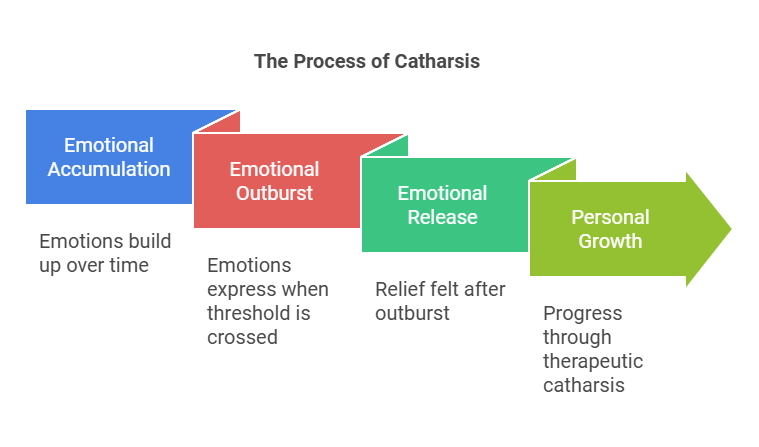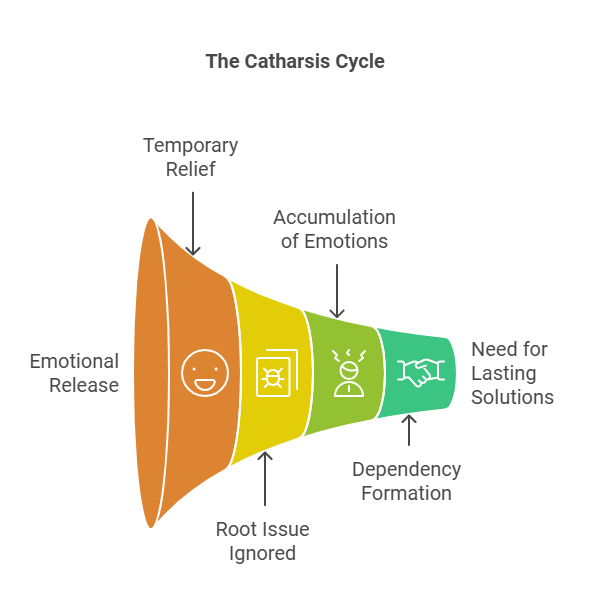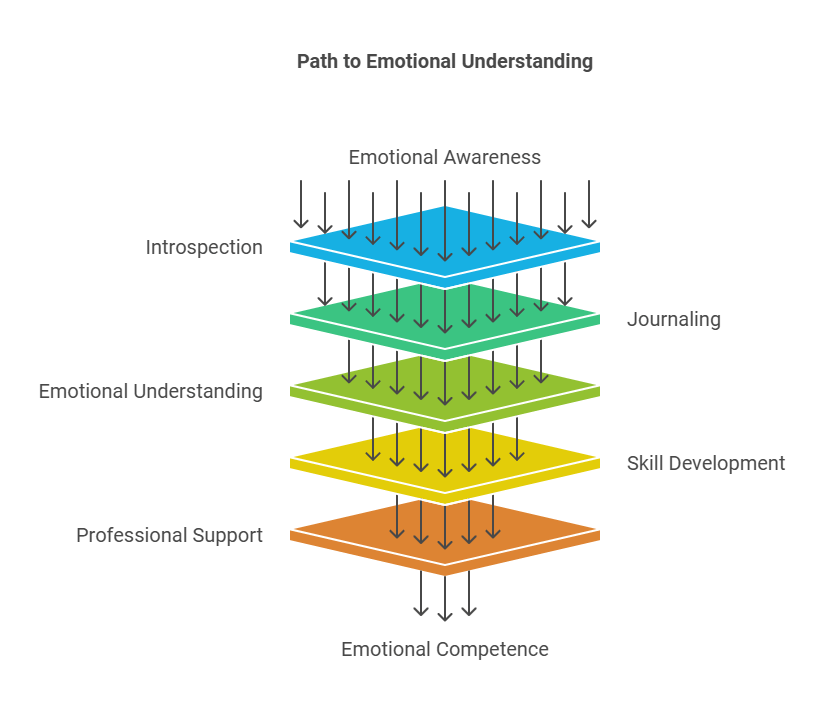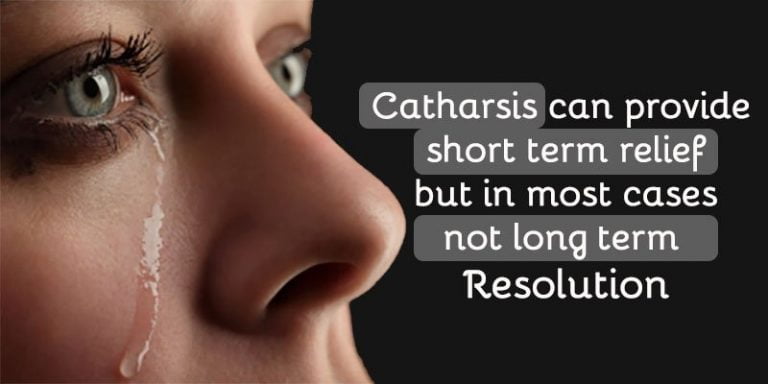In this article, we’ll delve into the intricate concept of catharsis, exploring why it holds significance and, more importantly, why it often falls short in addressing emotional turmoil.
Many of us have experienced those challenging days when despair, depression, and helplessness seem to envelop us, leaving us yearning for an emotional release.
In our quest for inner peace, we often turn to what psychologists call “catharsis.”
What is catharsis?
Catharsis, as ancient as the Greek philosophers, finds its roots in Aristotle’s time. It’s a term that simply means “the process of releasing strong or repressed emotions.”

In layman’s terms, it’s the act of venting out pent-up emotions, a natural response to the accumulation of feelings such as anger, sadness, jealousy, hatred, or guilt.”
And how do we do that?
How do we release our emotions?
Natural process of venting out

Emotions that accumulate within us over time, causing distress, naturally seek an outlet. When we haven’t learned constructive ways to express these emotions, they may eventually find expression in the form of an “outburst” once a certain threshold is crossed.
Following this emotional release, we typically experience a sense of relief and lightness. This feeling of relief and lightness is significant as it can serve as a crucial step in our personal growth and progress in life.
This is why catharsis, which involves controlled emotional release in a therapeutic environment, plays a vital role in many psychotherapeutic techniques.
The Problem with Catharsis

While catharsis can provide temporary relief by releasing pent-up emotions, it often fails to address the root issues, making it an imperfect solution.
For example, consider the act of breaking objects and shouting in frustration at a coworker. This not only leads to material loss but also hinders the potential for resolving the underlying issues with that coworker.
More constructive ways of emotional release include engaging in various activities and creative arts, such as painting, sculpting, dancing, cooking, writing, exercising, or even allowing oneself to cry.
While some of these forms of catharsis can be productive (history has shown that great art often arises from intense emotions), they may not offer long-term emotional health.
The challenge lies in the fact that catharsis tends to address the symptom, helping individuals momentarily “free” themselves from negative emotions, without delving into the reasons behind those emotions. Consequently, the emotions continue to accumulate, and the need for catharsis resurfaces over time, potentially leading to a vicious cycle.
One may become dependent on this technique as a way to feel good, albeit temporarily, ultimately creating a habit or dependency. In other words, catharsis may function like a painkiller, with its effectiveness diminishing over time or requiring increased use.
This scenario is less than ideal, and it underscores the importance of seeking more comprehensive and lasting solutions for emotional well-being.
If catharsis is not enough, then what is?
The best way to help ourselves would then obviously require us to not only treat the symptom (to provide short term relief) but also the cause (to make this relief sustainable in the long run by reducing the chances of relapse).
Catharsis, as we already know, can help with the symptom but how does one exactly identify the cause, let alone work with it?

- One way, that is self-reliant, of identifying cause is “introspection & giving yourself time (to know oneself, people & situations better).
- You can keep a journal of your emotions with details about when you felt them & what were the triggers that led to these emotions.
- You could also consider writing the actions that you can take to avoid the triggers or to develop the skills which will help you handle the triggers more effectively.
- Understanding the emotions that you are experiencing and the purpose of those emotions can go a long way in helping you identify the skills and the steps needed to work with the cause. The “Advanced FLIP Model” can be a very powerful starting point for the same.
- However, if the emotion is too intense or you feel unable to cope up with the situation by yourself, then one must go for counseling or therapy session. Going to a specialist in mental health will provide you a safer, more controlled environment where you can not only work with the symptoms & causes but also develop overall skills and life competencies.
- Investing in quality self-help workshops can also help in developing competencies that you can benefit from in the long run.
Therapist Niche: Techniques to use along with Catharsis
Now that we know what is catharsis and that it is not enough, it is important for therapists to find effective ways of helping clients overcome emotional challenges.
Remember helping the client resolve a problem or get out of a difficult situation is not just about creating a change but about creating sustainable change.
Sustainable change depends on helping the client not only let go of uncomfortable emotions triggered by people or situations but also
- Understand and deal with the root cause behind the problem
De-layering techniques like corrective therapy, free association, SVIT™, Regression in combination with release processes like Hypnodrama, Inner Child, Ho’ponopono, Regression therapy and metaphors from Hypnotherapy and NLP can be used by the client. - Access powerful emotional states
Hypnotic Suggestions, Anchoring, Core transformation, advanced sub-modalities and levels of transformation can be used for the same. - Identify required skills and key learning’s that needs to be applied to prevent relapses.
Revelation metaphors and Meta Model Questions can be used to identify the skills and learning’s. Modelling and future pacing can be used to help the client develop the required skills and apply the learning in their life.
Summary of What is Catharsis?
In a world where emotions play a profound role in our well-being, understanding and managing them is paramount. While catharsis may provide temporary relief, it often falls short in addressing the underlying causes of emotional distress.
To truly achieve emotional well-being, we must dig deeper, identify the root causes, learn life lessons and develop the necessary skills. Whether through introspection, professional therapy, or self-help workshops, the path to lasting emotional balance is within reach.
If you are a mental health practitioner who would like to learn these processes and further enhance your therapeutic repertoire, it is time for you to join our comprehensive program for mental health professionals. You will learn all these techniques and a lot more during the program.
Disclaimer
*¹ We do not label emotions as positive or negative… as each emotion is important & serves a purpose. Here… the expression “negative emotions” is used for ease in understanding!
References for What is Catharsis
- Bushman, B. J., Baumeister, R. F., & Stack, A. D. (1999). Catharsis, aggression, and persuasive influence: Self-fulfilling or self-defeating prophecies?. Journal of personality and social psychology, 76 (3), 367.
- Powell, Esta. “Catharsis in psychology and beyond. ” (1995).
- Breuer, J. O. S. E. F. (1957). Freud S: Studies on hysteria. The Standard Edition of the Complete Psychological Works of Sigmund Freud, 2, 1893-1895.Nichols, M. P., & Zax, M. (1977). Catharsis in psychotherapy. Gardner Press.
- Nichols, M. P., & Efran, J. S. (1985). Catharsis in psychotherapy: A new perspective. Psychotherapy: Theory, Research, Practice, Training, 22 (1), 46.

